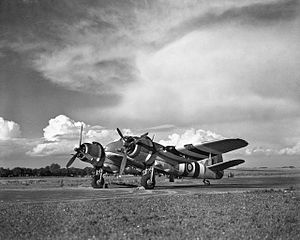No. 455 Squadron RAAF
| No. 455 Squadron RAAF | |
|---|---|

A No. 455 Squadron Beaufighter in 1944
|
|
| Active | 23 May 1941 – 26 May 1945 |
| Country | Australia |
| Allegiance | United Kingdom |
| Branch | Royal Australian Air Force |
| Role |
Bomber Torpedo bomber |
| Part of | No. 5 Group, Bomber Command (Jun 41 – Apr 42) |
| Motto(s) | Strike and strike again |
| Battle honours |
English Channel and North Sea, 1939–1945 Baltic, 1939–1945 Fortress Europe, 1940–1944 France and Germany, 1944–1945 Ruhr, 1940–1945 Berlin, 1940–1945 German Ports, 1940–1945 Normandy, 1944 Arctic, 1940–1945 Russia, 1941–1945 |
| Insignia | |
| Squadron badge heraldry | In front of two battle axes in saltire a winged helmet |
| Squadron codes |
UB (Jun 1941 – Aug 1943, Jul 1944 – May 1945) 2 (Aug 1943 – Jul 1944) |
| Aircraft flown | |
| Attack | Bristol Beaufighter |
| Bomber | Handley Page Hampden |
No. 455 Squadron was a Royal Australian Air Force (RAAF) torpedo bomber squadron during World War II and became famous as part of the "ANZAC Strike Wing" that was formed from Australian and New Zealand squadrons. Raised in early 1941, mainly from Australian personnel, the squadron served over Europe during the war, operating from various bases in the United Kingdom; it also briefly sent a detachment to the Soviet Union in 1942. Operating Handley Page Hampdens and Bristol Beaufighters, the squadron mainly undertook anti-shipping and anti-submarine operations during the war. It was disbanded in May 1945 following the cessation of hostilities against Germany.
No. 455 Squadron was formed on 23 May 1941 as an Article XV squadron and officially raised at Williamtown, New South Wales. Established under the Empire Air Training Scheme, the squadron was formed for service in Europe with the Royal Air Force and although nominally an Australian squadron, its personnel were drawn from a number of Commonwealth countries including Britain, Canada, New Zealand and Rhodesia. While the main body waited to be shipped to the UK, other Commonwealth personnel, drawn mainly from the RAF, concentrated RAF Swinderby, in Lincolnshire and on 6 June 1941 the squadron was formally established.
The squadron received Hampden bombers and the bulk of the Australian personnel arrived on 1 September 1941, having departed Australia on 15 June. Initially assigned to No. 5 Group RAF, Bomber Command in a bomber role, its first operation took place while the squadron was still forming, when a single Hampden attacked Frankfurt at night on 29 August. In doing so, according to the Australian War Memorial, the squadron had the distinction of becoming the "first Australian squadron to bomb Germany". Following this, the squadron increased its operational tempo, undertaking several mine laying operations off the coast of occupied France, as well attacking industrial targets in Germany.
...
Wikipedia
